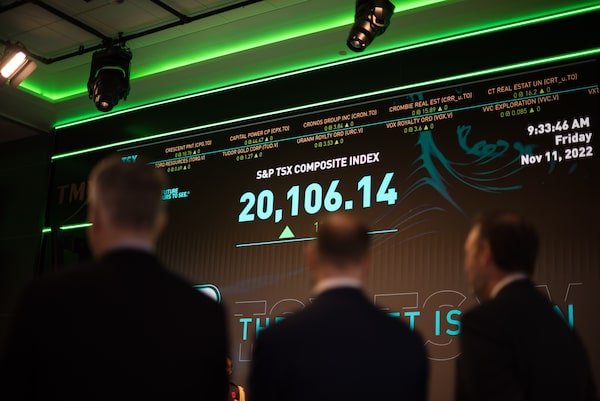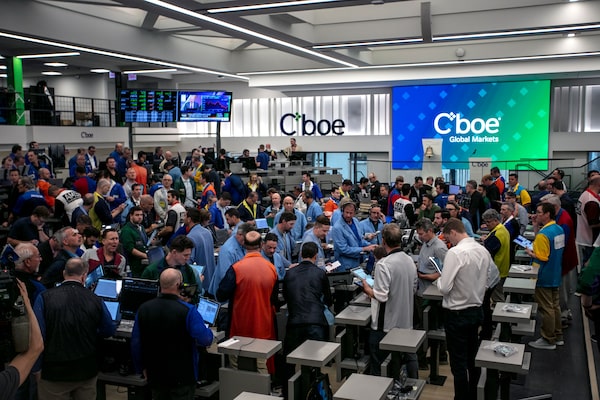Jos Schmitt, co-founder, president & CEO of the NEO Exchange, at the exchange office in Toronto, on Feb. 17.Christopher Katsarov/The Globe and Mail
NEO needs a whale.
Unless Canada’s upstart NEO Exchange can snag a whale of a corporate listing, comparable to when Microsoft Corp. listed on the Nasdaq Stock Market in the 1990s, experts say NEO Exchange Inc. will struggle to rival TMX Group Ltd. and its flagship Toronto Stock Exchange.
Eight years after launching with the objective of taking on the TSX in the same way the Nasdaq now rivals the New York Stock Exchange (NYSE) in the United States, NEO appears to have made little progress.
Despite attracting scores of exchange-traded fund (ETF) listings and being acquired by Cboe Global Markets Inc. in 2021, NEO was home to just 56 public companies as of Feb 15. That compares with 781 senior corporate issuers listed on the TSX as of Jan 31.
But NEO co-founder and chief executive officer Jos Schmitt still believes he is still on track to build the Nasdaq of the north.
Mr. Schmitt still believes he is on track to build the Nasdaq of the north with NEO Exchange.Christopher Katsarov/The Globe and Mail
“When you look at our journey, in fact you can compare it very much to the journey that the Nasdaq went through … in the ‘90s,” he said in a recent interview. “They serviced the companies that NYSE was not willing to service or was not able to service or was struggling to service, and there is also a space where there was, and still is, a void in the Canadian market.”
But success will require more than simply convincing more private companies to eschew the TSX in favour of NEO’s platform when going public. If NEO truly hopes to topple the TSX monopoly, it must build a brand strong enough to lure large issuers away from the incumbent. And existing Canadian index rules make that all but impossible.
Members of major indexes such as the S&P/TSX 60 Index are effectively banned from leaving the TSX without losing their lucrative index membership. As a result, even though Royal Bank of Canada was among NEO’s founding shareholders, moving its stock listing to that exchange would get RBC booted from the S&P/TSX 60. Many large investors and fund managers require index membership for holding a stock, meaning they would all be forced to sell their RBC shares if that circumstance were to arise.
“That ultimately prevented RBC and a number of our other shareholders, who are also public companies, from embracing our exchange with their listings,” Erik Sloane, NEO’s chief revenue officer, said in an interview. “There is that one little rule at the bottom of that piece of paper that says you must be listed on the TSX to be in the index.”
Richard Carleton helped to write those rules when he was vice-president of index and market data services at the TSX in the late 1990s. The S&P/TSX 60 launched at the end of 1998.
Richard Carleton, now the CEO of the Canadian Securities Exchange (CSE), helped to write the existing Canadian index rules when he was vice-president of index and market data services at the TSX in the late 1990s.Michelle Siu/For The Globe and Mail
Now, as CEO of the Canadian Securities Exchange (CSE), which primarily lists junior companies with relatively small market capitalizations, those rules have come back to haunt him.
“It is an issue that has been a concern for us and for, shall we say, other competitors in Canada,” Mr. Carleton said in an interview. “The incumbent exchange group really has a monopoly on index membership.”
While the major indexes in the United States, such as the 30-stock Dow Jones Industrial Average or the S&P 500, do not require members to be listed on a particular exchange, Mr. Carleton notes that was not always the case.
“It used to be that you had to be listed on the New York Stock Exchange” in order to join an index, he said. “It wasn’t until the 1990s when they began including [Nasdaq-listed] companies like Microsoft in the S&P 500 [and] that was only after portfolio managers and pension funds who are benchmarked off of those indices basically said to S&P, ‘What are you doing excluding these huge drivers of economic growth?’ ”
It would take a similar groundswell to get the same thing to happen in Canada, Mr. Carleton said. “And to do that, it is going to take quite a large concentration of market cap somewhere other than the TSX-owned exchanges.”
That is where, he said, an upstart challenger needs “a little help from the incumbent” in order to be successful.
“Whether it is an industry sector that they overlook or they choose not to service for whatever reason, then there is an opening for a newcomer,” Mr. Carleton said.
Nasdaq, for example, was able to take advantage of NYSE rules preventing companies that had yet to earn revenue from listing on the exchange. By offering capital markets access to Microsoft and other soon-to-be tech giants such as Apple Inc., Intel Corp. and Cisco Systems Inc., Nasdaq was able to carve out a lucrative niche for itself.
NEO is taking a very similar, though slightly broader approach, targeting what Mr. Schmitt terms “the innovation economy.”
“All those new types of businesses in the life sciences space and the fintech space and the clean-tech space, they saw that the incumbent exchange was having a hard time understanding them, understanding their business models and what they wanted to achieve,” Mr. Schmitt said. “We decided to put more and more of our focus on that.”
Cryptocurrency and blockchain-based businesses, carbon credit investing firms and psychedelic pharmaceutical research companies figure prominently among NEO’s corporate listings. One issuer, Maritime Launch Services Inc., is even developing a spaceport in Nova Scotia to send satellites into orbit.
The parallels to Nasdaq are undeniable, except for one crucial difference: the TSX has no intention of letting NEO have the so-called “innovation economy” to itself.

The S&P TSX composite index screen at the TMX Market Centre in downtown Toronto on Nov. 11, 2022.Tijana Martin/The Canadian Press
TSX CEO Loui Anastasopoulos has a business development team dedicated to engaging with science and tech companies, including those already listed on other public exchanges, with the explicit goal of convincing them to move their listings to the TSX.
“One thing that is important to point out in that respect is in 2021, for the first time ever, our technology franchise surpassed our mining franchise in Canada in terms of market cap,” Mr. Anastasopoulos said in an interview. “If you had told me 10 years earlier that would happen I would have laughed at you.”
WonderFi Technologies Inc. is one relatively recent example of the TSX successfully attracting a listing away from NEO. The Vancouver-based operator of cryptocurrency exchanges Bitbuy and Coinberry initially went public on the NEO in August, 2021, only to switch to the TSX less than one year later, in June, 2022.
NEO’s Mr. Schmitt claims there was a “very intense debate” at WonderFi “about whether or not they should move their listing.” But from the company’s perspective, the decision was easy.
“We approached the TSX, and for a public company, if we are able to list on the TSX with its broader reach and access to a wider investor base, that was super compelling for us,” said Dean Skurka, WonderFi’s president and interim chief executive. “It has definitely given us more exposure publicly and opened up our ability to attract a wider audience of investors.”
WonderFi, according to Mr. Anastasopoulos at the TSX, was one of “probably 150 conversations we would have had last year with companies on other marketplaces.”
NEO, meanwhile, has managed to poach from the incumbent exchange as well. Alpha Lithium Corp., which had previously listed on the TSX Venture Exchange, also owned by TMX Group, chose to uplist on NEO in last September, instead of moving to the TSX main board.
“I’m not interested in bashing the TSX, it is a big institution, but I remember when we listed the company on the Venture, it was a difficult process, it was just a grind,” said Brad Nichol, Alpha Lithium’s CEO. “It felt, I think monopolistic is maybe the right term.”
NEO, by comparison, “has thrilled me,” Mr. Nichol said. “They are very customer-centric and customer focused. They want to be helpful. They want to offer a service. I don’t want to say aggressive, but they are keen.”
Keenness aside, NEO is nonetheless facing intense competition as it seeks to be the exchange of choice for companies considered part of the innovation economy.
“It is not like this is some kind of forgotten corner of the Canadian marketplace and [NEO] is taking advantage of it,” said Jaeme Gloyn, an analyst at National Bank Financial who covers the TMX Group. “Something we track periodically with the TSX is how well they are doing with innovation industries like life sciences and they have actually been fairly successful in terms of growing there.”
The CSE, meanwhile, is also hoping to take a slice of the innovation economy pie for itself.
“There is no unique or special sauce at any particular trading venue which informs or would drive a company one direction or another on that basis alone,” said Mr. Carleton. “We are all alert to and supportive of the innovation economy.”
Part of the NEO strategy is to pursue ETF listings, which Mr. Schmitt described as “the low-hanging fruit.” He estimates between 30 and 40 per cent of all new ETF listings in Canada debut solely on NEO.
ETF providers have more incentive to list on different exchanges in order to encourage more competition on fees, though the trade-off is they are far less valuable to the bottom line of the exchange itself.
When Cboe announced its plan to acquire NEO in November, 2021, National Bank’s Mr. Gloyn sent a note to clients dismissing any potential threat the deal might pose to TMX, regardless of how many ETF listings NEO might amass.
“We do not see a significant increase in competitive risk for TMX,” he wrote at the time. “Importantly, corporate listings generate significantly more revenue than exchange-traded products.”

Traders work on the floor of The Chicago Board Of Options Exchange (CBOE) in June 2022 in Chicago. In November 2021, CBOE announced its plan to acquire NEO.Jim Vondruska/Getty Images North America
Yet, because Cboe also operates other exchange businesses around the world, NEO’s Mr. Sloane sees the acquisition as game-changing given the exchange now boasts a global footprint just as the TSX expands its ambitions beyond Canada.
“We have become our own 800-pound gorilla to have fun against the TSX,” he said. “It has changed all of our conversations.”
No matter its size, NEO’s inability to list any major index members remains at odds with its primary mission of attracting senior-level corporate issuers.
“The exclusivity that the TSX has with S&P on those indices is a debate that will re-emerge because it is clear that it is anti-competitive, but it is not preventing us from growing our business,” said Mr. Schmitt. “These are all things that Nasdaq went through as well.”
Given enough time, Alpha Lithium’s Mr. Nichol is among those who believe NEO is still capable of achieving Nasdaq-level success.
“If every issuer had the same experience that I had with NEO, and dealing with NEO, and going through their listing process, I think a lot more of them would gladly list on the NEO Exchange,” he said.
It took Nasdaq nearly 40 years to be seen as the NYSE’s peer, according to NEO’s Mr. Sloane.
“We’ve been at this for eight years in Canada and we still have a lot of work to do to form up the same kind of competition,” he said. “But we have the time to do it and we will.”
 Jameson Berkow
Jameson Berkow